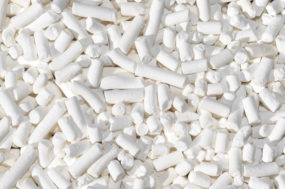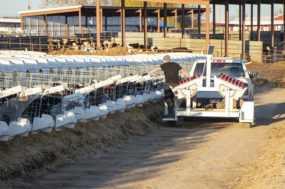Once again in 2009, dairy farmers will be struggling to cope with the downside of milk price volatility, with farm prices down sharply from 2008.
In addition, cost of production will be higher than in years past, but somewhat lower overall than in 2008. The result will be a very difficult year from a cash flow standpoint.The USDA price forecast for milk on the farm is dire indeed. However, in recent weeks the futures market prices for Class III milk has tended to rise, which indicates higher milk prices than the USDA forecast. On April 1, Class III futures average $13.51 per hundredweight for the remainder of the year, but are higher in the later part of the year. The differences in these two price scenarios likely hinge mainly upon the speed with which production responds to the financial pressures caused by low milk prices and higher production costs. This means that a large number of dairy cows will need to be culled to restore the balance between supply and demand. It is hard to believe this adjustment will be as slow as the current USDA forecast because of the financial stress on dairy farmer incomes. But such speculation leans towards higher prices than the futures market is indicating.
No MILC payments were made in 2008 or in January 2009. However, payments for February will be $1.51 per hundredweight, should increase for March, and then decrease through fall. Payments can be found at www.fsa.usda.gov/
Because feed prices have moderated, the feed cost adjuster is not expected to generate large changes in the price trigger, probably $0.15 to $0.20 per hundredweight. The National Milk Producers Federation provides MILC payment projections based on current futures prices on their website at www.nmpf.org. Farms are eligible for MILC payments on up to 2.985 million pounds of milk sold per fiscal year. For farms under the payment cap, MILC payments will be around $0.75 per 100 pounds, on average.
Tips for tough economic times
• Spend wisely.
There are always things that you have to buy, but hunker down and spend only what you need. However, you don’t want to cut down on feed and semen and other items that can cost you in the future.
• When spending, calculate what the return on investment is and prioritize accordingly.
Always keep good records so that you know what your return on investment is. Put a pencil to any expenditures and see what return on investment you will get. Review your equipment, facilities and feedstuffs to see where you will have to spend money and plan accordingly.
• Plan your budget so that cash flow problems will be minimized.
Especially over the next two months, cash flow may be negative. Think about where you can get cash if needed.
• Have a good association with your banker.
As one producer said, the belt is out of notches and can’t be tightened any more. You may need to borrow money. Tell your banker the good and the bad. Don’t borrow your last dollar so that if you have to sell cows or other items to make it, your cows and facilities are in such bad shape that they don’t bring anything. Make sure that you have enough reserves to keep everything in acceptable condition. If necessary, restructure your debt payments and possibly borrow more operating funds if you will be able to pay them back.
• From a personal standpoint, you can consider (not usually recommended) selling non-farm assets, e.g., timber and items used purely for recreation.
You may have some extra farm equipment that has not been used recently and that can be sold. In some cases, it might make sense for family members to seek off-farm income to aid in paying the bills. Family living expenses should be minimized.
• Traditionally, dairy farms have sold cows or heifers to meet short-term cash flow needs.
That helps your cash flow status and decreases the amount of milk going to market. However, consider what the long-term effect will be when the cows or heifers are sold.
• Emphasize cleanliness and health prevention for the dairy since these are small out-of-pocket costs, but can prevent or minimize much greater costs if animals get sick from mastitis and other illnesses.
Review your operation to make sure that cow comfort is not limiting milk production. Try to minimize the cows’ contact with mud. Make sure that cows have shelter when the weather is cold and have a dry place to rest all the time.
• Make sure your ration is balanced for your level of production.
Do not cut back on your feed in the milking parlor or grain in the TMR to the point that you end up with thin cows.
• Feed cows according to their level of production.
High-producing cows require a greater concentration of energy in the diet in order to consume enough nutrients to produce large quantities of milk.
• If you are in a situation where pasture is available, it is usually more economical to provide the cows with high-quality forage now to ensure that their milk production level is maintained rather than allowing them to lose their body condition.
Plant annuals in a timely manner in order to maximize the amount of forage that you get from pastures or harvested feed.
• Ensure that fresh feed and water are available to cows at all times.
Too often producers who are short on money will cut feed for the cows, the cows become thin, and then they can’t produce large quantities of milk when milk prices rise. Minerals also must be provided to cows at all times or decreased reproductive performance and milk production may result. Buffers are almost always a good investment when cows are on a high-grain diet.
• Check limiting nutrients in the soil with soil tests which don’t cost you.
Always consider the advantages of manure as an economical source of fertilizer for forages and other crops.
• Watch feet health while pastures are wet.
Rotate pastures often so that feet are not damaged in the muddy areas. Give the muddy, chewed-up areas time to dry out and heal so that forages will grow better. Rotating pastures also decreases the likelihood of udders being contaminated with organisms that cause mastitis. Consider a chelated mineral that improves both udder health and feet if high SCC and/or feet are a problem.
• Plan now for next summer.
Consider adding fans and sprinklers in your holding pen before the summer heat is here, if you don’t have them already.
• Plan forages for next summer.
Since grain prices are expected to be high, plan for as many high-quality forages as possible in order to reduce grain feeding.
• Rotate pastures to keep cows out of the mud and reduce mastitis in cows.
Environmental, mastitis-causing bacteria produce toxins and other irritants that damage milk-producing cells, and then cause a loss in milk production. If destruction occurs, the cells are replaced permanently by scar tissue. A single quarter that is infected for one lactation may reduce milk production by 10 to 12 percent. Therefore, when wet, muddy weather arises, a barrier teat dip may decrease the incidence of new infections in the udder. Discuss these more expensive teat dips with your veterinarian or supply salesperson.
• Make use of your county agent.
He/she can help you balance rations, conduct soil testing, conduct forage testing, review your dairy management and many other things.
Don’t hesitate to contact your local FSA office to see what programs they have available. Everyone should sign up for the MILC program – although the timing may vary if you produce more than three million pounds of milk.
Don’t change a lot of things at one time. Put a pencil to any change and see how it affects your long-term profits. If you need assistance on specifics, contact your local county extension agent or another competent person in your management team, and he/she will be glad to provide assistance to you. PD
Geoff Benson
Extension Economist
North Carolina State University
geoff_benson@ncsu.edu
Jodie Pennington
Dairy Specialist
University of Arkansas
jodiepennington@gmail.com






